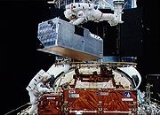
Corrective Optics Space Telescope Axial Replacement
Encyclopedia
The Corrective Optics Space Telescope Axial Replacement (COSTAR) is the instrument designed to correct Hubble Space Telescope
's spherical aberration for light focused at the FOC
, FOS
and GHRS
instruments. Built by Ball Aerospace Corp., it replaced the High Speed Photometer
(HSP) during the first Hubble Servicing Mission
in 1993. Later instruments, installed after HST's initial deployment, were designed with their own corrective optics.
COSTAR was removed from HST in 2009 during the fifth servicing mission
and replaced by the Cosmic Origins Spectrograph
. It is now on exhibit in the Smithsonian's National Air and Space Museum
.
Hubble Space Telescope
The Hubble Space Telescope is a space telescope that was carried into orbit by a Space Shuttle in 1990 and remains in operation. A 2.4 meter aperture telescope in low Earth orbit, Hubble's four main instruments observe in the near ultraviolet, visible, and near infrared...
's spherical aberration for light focused at the FOC
Faint Object Camera
The Faint Object Camera was a camera installed on the Hubble Space Telescope from launch in 1990 until 2002. It was replaced by the Advanced Camera for Surveys.The camera was built by Dornier GmbH and was funded by the European Space Agency...
, FOS
Faint Object Spectrograph
The Faint Object Spectrograph was a spectrograph installed on the Hubble Space Telescope. It was replaced by the Space Telescope Imaging Spectrograph in 1997, and is now on display in the National Air and Space Museum in Washington DC. -FOS facts:...
and GHRS
Goddard High Resolution Spectrograph
The Goddard High Resolution Spectrograph was a spectrograph installed on the Hubble Space Telescope. It was replaced by the Near Infrared Camera and Multi-Object Spectrometer in 1997.-GHRS facts:...
instruments. Built by Ball Aerospace Corp., it replaced the High Speed Photometer
High Speed Photometer
The High Speed Photometer was a scientific instrument installed on the Hubble Space Telescope. The HSP was designed to measure the brightness and polarity of rapidly varying celestial objects. It could observe in ultraviolet, visible light, and near infrared at a rate of one measurement per 10...
(HSP) during the first Hubble Servicing Mission
STS-61
STS-61 was the first Hubble Space Telescope servicing mission, and the fifth flight of the Space Shuttle Endeavour. The mission launched on 2 December 1993 from Kennedy Space Center in Florida. The mission restored the spaceborne observatory's vision, marred by spherical aberration, with the...
in 1993. Later instruments, installed after HST's initial deployment, were designed with their own corrective optics.
COSTAR was removed from HST in 2009 during the fifth servicing mission
STS-125
STS-125, or HST-SM4 , was the fifth and final space shuttle servicing mission to the Hubble Space Telescope .Launch occurred on 11 May 2009 at 2:01 pm EDT...
and replaced by the Cosmic Origins Spectrograph
Cosmic Origins Spectrograph
The Cosmic Origins Spectrograph is a science instrument that was installed on the Hubble Space Telescope during Servicing Mission 4 in May 2009. It is designed for ultraviolet spectroscopy of faint point sources with a resolving power of ≈1,550–24,000...
. It is now on exhibit in the Smithsonian's National Air and Space Museum
National Air and Space Museum
The National Air and Space Museum of the Smithsonian Institution holds the largest collection of historic aircraft and spacecraft in the world. It was established in 1976. Located in Washington, D.C., United States, it is a center for research into the history and science of aviation and...
.

